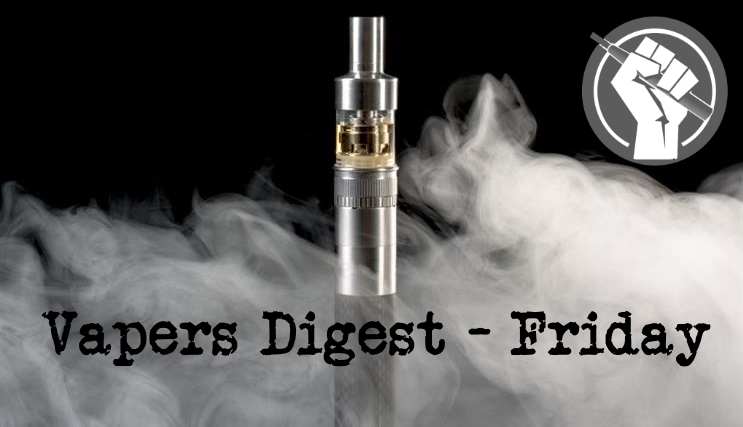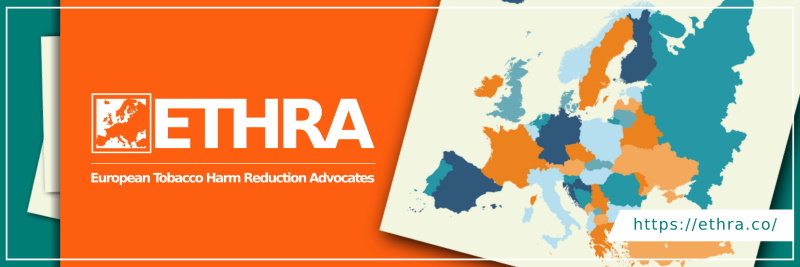Vapers Digest 7th July

Friday’s News at a glance:
NNA writes to the Health and Social Care Committee – Astounding Smoking & Vaping Statistics in New CDC Data – Smoke-free Sweden ‘unlikely’ in 2023 – Global Forum on Nicotine Remains Crucial – FDA Receives Expert Letter – GFN23: Day 3 & 4 – Follow The Science – Talking rot – attention-seeking headings that fail – Anti-tobacco advocate says vapes an overall positive – Anti-smoker bill ignores science – Nicotine Science and Policy Daily Digest
Health and Social Care Committee
New Nicotine Alliance
On Wednesday 28 June, the government’s Health and Social Care Committee held an oral evidence session on youth vaping. It consisted of two panels of witnesses who gave evidence and were questioned by MP members of the committee.
We watched proceedings on Parliament TV and were disappointed that much of the discussion wasinaccurate and often ill-informed. In light of this, we have written to the committee today to highlight the many inaccurate, misleading, or false statements and remarks during the hearing. We hope committee members will recognise these areas of concern and take them into account when considering their future recommendations.
The full parliamentary session online at this link, and the transcript has been published here. You can read our letter in full here, or below.
Astounding Smoking & Vaping Statistics
Brad Rodu, Tobacco Truth
The U.S. Centers for Disease Control (CDC) just released the full data set from the 2022 National Health Interview Survey (NHIS). Earlier, the agency published “Early Release of Selected Estimates Based on Data From the 2022 National Health Interview Survey,” a document that reflected the CDC’s propensity to cherry-pick data in order to portray all forms of tobacco as deadly and evil.
The chart at left shows the prevalence of smoking and vaping among American adults over the years the survey collected information on vaping — 2014 to 2022. Note that the smoking rate, denoted by the black and gray columns, started out at 16.8% and has since declined to 11.6%, for a drop of about 31%. During that time, the vaping rate increased from 3.7% in 2014, to 6% last year.
Smoke-free Sweden ‘unlikely’ in 2023
Due to nicotine ‘scaremongering’ – Snusforumet
A lack of factual information from Sweden’s public health bodies and continued nicotine “scaremongering” means it’s unlikely Sweden will celebrate reaching the WHO definition of smoke-free by the end of 2023, says Patrik Strömer, head of the Association of Swedish Snus Manufacturers.
The warning comes in an interview with Snusforumet summarizing Strömer’s impressions from Almedalen, a recently concluded political gathering held every year in Visby on the Baltic island of Gotland.
When asked whether 2023 would be the year Sweden achieved smoke-free status, defined by the WHO as a daily smoking prevalence below five percent, Strömer said, “No, but we’ll get closer.”
Today’s @NNAlliance letter to the UK Health & Social Care Select Committee is just brilliant.
Best thing I’ve read in weeks!
h/t @grannylouisa https://t.co/mVPz07rTlh
— Clive Bates (@Clive_Bates) July 6, 2023
“At a time when a study shows a sharp increase in cancers in France, let us recall the Call by doctors to integrate #vaping against smoking to avoid cancers launched in 2021 by Sovape, which remained without an adequate response from the authorities” https://t.co/qdtxLNvKEq
— European Tobacco Harm Reduction Advocates (@europethra) July 6, 2023
Global Forum on Nicotine
Remains Crucial to Harm Reduction – Helen Redmond
The Global Forum on Nicotine (GFN) has just been held for the 10th time. It’s been a helluva decade! GFN has been a lonely, brave platform in robustly exploring and unapologetically promoting tobacco harm reduction (THR).
That’s a critical role in the face of a global war on THR—funded in large part by billionaire Michael Bloomberg’s funneling millions to fanatical anti-vaping groups—which has restricted access to harm reduction for countless millions of people who smoke. Even the World Health Organization has been influenced by Bloomberg’s opposition to safer nicotine producers (SNP). Add a global corporate media ever-eager to whip up a vaping panic, spread disinformation based on junk science and demonize nicotine, and the future looks bleak. Or does it?
Four from Dave Cross, Planet of the Vapes:
FDA Receives Expert Letter
A group of 23 academics and experts have written to the US Food and Drug Administration Commissioner, Robert Califf, with proposals for the adoption of an enhanced regulatory approach for vaping. The letter follows up on a “critical Reagan Udall Foundation evaluation”, highlighting the FDA’s “lack of coherent regulatory strategy as a core weakness”.
The authors included: David Abrams, Scott Ballin, Clive Bates, Neal Benowitz, Michael Cummings, Cliff Douglas, Jonathan Foulds, Tom Glynn, Martin Jarvis, Lynn Kozlowski, David Levy, David Mendez, Robn Mermelstein, Rafael Meza, Tom Miller, Ethan Nadelmann, Ray Niaura, Vaughn Rees, Steve Schroeder, David Sweanor, Jamie Tam, Kenneth Warner, and Daniel Wikler.
GFN23: Day 3
In ‘The politics of scientific publishing’, Sarah Cooney pointed out: “There are lots of problems with peer review. Science publishing is this massive industry built on the back of unpaid work by volunteers, including the peer reviewers. The peer review community is under more and more pressure. Journals are receiving more and more submissions all the time, so what they are starting to do to cope with this and reduce the burden on their communities is to reject without review.”
She warned against “predatory journals” that represent the “downside to the open access business model” and led to the barrier of entry becoming “super low”.
GFN23: Day 4
Presenting his view on a rigorous critical evaluation of tobacco and nicotine science, Dr Roberto Sussman said: “We have to be very firm. When we argue with the [anti-vaping] side, we have to argue with information. When they say ‘there’s a vaping epidemic with the youth’, we have to say ‘no, there’s no vaping epidemic’. If you want to talk about a vaping epidemic, we talk about politics. But there is no science in that. If we say ‘unfortunately, there’s a vaping epidemic but fortunately it’s decreasing’ then we are playing into their narrative.”
The panel discussing ‘The changing face of nicotine’ heard from Dr Paul Newhouse. He said: “We understand that nicotine stimulates receptors systems in the brain that are important for regulation of mood, cognition and a variety of neural functions. It turns out that the effects are very state-dependent, they are age dependent and may even be sex dependent. …”
Follow The Science
New Zealand should continue to follow the science, according to the Coalition of Asia Pacific Tobacco Harm Reduction Advocates (CAPHRA). The organisation is calling on the Kiwi government to reject Australia’s misguided approach to vaping and continue to follow the science and evidence.
CAPHRA has submitted comments on New Zealand’s proposals for the smoked tobacco regulatory regime, which include tightening current restrictions on vaping product safety requirements and packaging and reducing nicotine levels in disposable vapes as well as restricting the location of specialist vape retailers.
Talking rot – attention-seeking headings
That fail to meet any standards of reality – Aidan Semmens
For years this blog has taken occasional swipes at some of the inanities that appear constantly in press and media coverage of vaping matters, but the headline on an otherwise fairly well written piece in PoliticsHome this week deserves some kind of award for nonsense – maybe something from the Boris Johnson honours cupboard.
It says: “Disposable vapes that do not meet UK standards should be banned”. Rather missing the point that not meeting standards means, by definition, that they are banned.
Anti-tobacco advocate says vapes …
An overall positive for public health
It seems these days there’s a vape shop on every street corner and while changes in New Zealand are planned, there’s still concerns that vaping has introduced a wave of new generation smokers ‘going digital’.
The Government have announced a ban on most disposable vapes from August, but one health professional says they’re a positive for public health overall.
Speaking on Breakfast this morning, Australian anti-tobacco campaigner Dr Colin Mendelsohn, says disposable vapes are a tool in helping people give up smoking cigarettes.
Anti-smoker bill ignores science
Ivo Vegter
Government is hell-bent on passing a draconian anti-smoker bill that sweeps away all before it, including vapes.
The cumbersomely titled Tobacco Products and Electronic Delivery Systems Control Bill, for which I could use the snappy and elegant acronym TPEDS Control Bill, but which I will instead call the anti-smoker bill, is an awful piece of legislation.
Tabled by the Department of Health (DoH), the bill aims to prohibit smoking and vaping in all indoor public places and many outdoor areas, including any outdoor area within a set distance of a door or window. (This distance could be as much as 50m, which will effectively outlaw smoking in any high-density built areas.)
On this Day…2022
A look back at how things have moved on or otherwise….
Independent review of tobacco policy…
In England misses the point – Clive Bates
England aims to reduce smoking to less than 5% by 2030, but this will need mass switching to smoke-free products as a consumer alternative to smoking, and it must be achieved by consent rather than coercion.
The government has established a ‘smoke-free’ goal to reach 5% adult smoking prevalence in England by 2030. This represents a significant acceleration in progress (see chart above with linear trends). As a prelude to announcing a plan to achieve the goal, Ministers appointed Javed Khan OBE to head an independent review of tobacco policy to make recommendations for measures to meet the target and contribute to reducing health inequalities.
Here is what Dr Khan has come up with:
England fans face prison or fines…
For taking vapes to World Cup due to strict Qatar laws
Rhys Daly, Daily Star
England fans who decide to travel to the World Cup in Qatar later this year may choose to play it safe and leave their e-cigarettes at home to avoid strong repercussions.
By the letter of the law, penalties for vaping in Qatar can include fines of up to 10,000 riyals (around £2,200) and even three month prison sentences due to regulations that came into force in 2014.
E-cigarettes have risen in popularity in the UK as both an alternative to smoking, with the process of vaping coming from the heating of a liquid that usually contains nicotine and flavourings.









